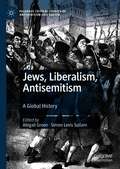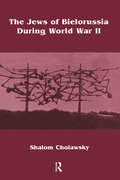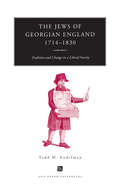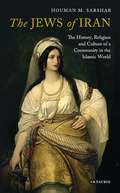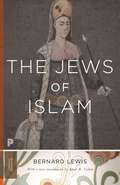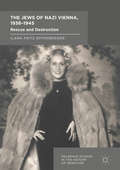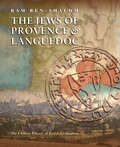- Table View
- List View
Jews, Labour and the Left, 1918–48 (Routledge Revivals Ser.)
by Christine Collette Stephen BirdThis title was first published in 2000. With the advent of the Second World War, fascism became inextricably associated with anti-Semitism. It is hardly surprising, therefore, to find that a significant number of Jewish people were politically inclined towards the left and were actively involved in socialist movements. The essays in this volume seek to arrive at an understanding of Jewish involvement in Labour movements outside Israel from the end of the First World War to the final stages of World War Two. This was a period which saw the creation of several international socialist institutions. Gail Malmgreen looks at the American Jewish Labor Committee and examines the interaction between trades unions and the Jewish community. Deborah Osmond, Christine Collette and Jason Heppell discuss the contributions made by Jews living in Britain to Labour politics, including the Communist Party of Great Britain and the Labour and Socialist International. The reactions and stances of the British Labour party in relation to Zionism and the Holocaust are the subjects of essays by Isabelle Tombs and Paul Kelemen. David De Vries's study of the position of Jewish white-collar workers in British-ruled Palestine provides another perspective on the complex web of relationships between British and Jewish identity, class, labour and politics. An invaluable bibliography by Arieh Lebowitz of sources for the study of Jewish interaction with the American and British Labour movements completes this important survey.
Jews, Labour and the Left, 1918–48
by Christine Collette Stephen BirdThis title was first published in 2000. With the advent of the Second World War, fascism became inextricably associated with anti-Semitism. It is hardly surprising, therefore, to find that a significant number of Jewish people were politically inclined towards the left and were actively involved in socialist movements. The essays in this volume seek to arrive at an understanding of Jewish involvement in Labour movements outside Israel from the end of the First World War to the final stages of World War Two. This was a period which saw the creation of several international socialist institutions. Gail Malmgreen looks at the American Jewish Labor Committee and examines the interaction between trades unions and the Jewish community. Deborah Osmond, Christine Collette and Jason Heppell discuss the contributions made by Jews living in Britain to Labour politics, including the Communist Party of Great Britain and the Labour and Socialist International. The reactions and stances of the British Labour party in relation to Zionism and the Holocaust are the subjects of essays by Isabelle Tombs and Paul Kelemen. David De Vries's study of the position of Jewish white-collar workers in British-ruled Palestine provides another perspective on the complex web of relationships between British and Jewish identity, class, labour and politics. An invaluable bibliography by Arieh Lebowitz of sources for the study of Jewish interaction with the American and British Labour movements completes this important survey.
Jews, Liberalism, Antisemitism: A Global History (Palgrave Critical Studies of Antisemitism and Racism)
by Abigail Green Simon Levis Sullam“This is a timely contribution to some of the most pressing debates facing scholars of Jewish Studies today. It forces us to re-think standard approaches to both antisemitism and liberalism. Its geographic scope offers a model for how scholars can “provincialize” Europe and engage in a transnational approach to Jewish history. The book crackles with intellectual energy; it is truly a pleasure to read.”- Jessica M. Marglin, University of Southern California, USAGreen and Levis Sullam have assembled a collection of original, and provocative essays that, in illuminating the historic relationship between Jews and liberalism, transform our understanding of liberalism itself. - Derek Penslar, Harvard University, USA“This book offers a strikingly new account of Liberalism’s relationship to Jews. Previous scholarship stressed that Liberalism had to overcome its abivalence in order to achieve a principled stand on granting Jews rights and equality. This volume asserts, through multiple examples, that Liberalism excluded many groups, including Jews, so that the exclusion of Jews was indeed integral to Liberalism and constitutive for it. This is an important volume, with a challenging argument for the present moment.”- David Sorkin, Yale University, USAThe emancipatory promise of liberalism – and its exclusionary qualities – shaped the fate of Jews in many parts of the world during the age of empire. Yet historians have mostly understood the relationship between Jews, liberalism and antisemitism as a European story, defined by the collapse of liberalism and the Holocaust. This volume challenges that perspective by taking a global approach. It takes account of recent historical work that explores issues of race, discrimination and hybrid identities in colonial and postcolonial settings, but which has done so without taking much account of Jews. Individual essays explore how liberalism, citizenship, nationality, gender, religion, race functioned differently in European Jewish heartlands, in the Mediterranean peripheries of Spain and the Ottoman empire, and in the North American Atlantic world.
The Jews of Bielorussia During World War II
by Shalom CholawskyFirst Published in 1998. This study fills a gap in the history of the fate of the Jews in Bielorussia during the Holocaust. The ghettos of Bielorussia were populated by a vibrant Jewish community, with its own particular traditions, its own unique characteristics justifying our detailed examination of its fate. In general, it may be said that every region, both in Eastern Europe and in other parts of the continent, differed from its neighbors.
The Jews of Bielorussia During World War II
by Shalom CholawskyFirst Published in 1998. This study fills a gap in the history of the fate of the Jews in Bielorussia during the Holocaust. The ghettos of Bielorussia were populated by a vibrant Jewish community, with its own particular traditions, its own unique characteristics justifying our detailed examination of its fate. In general, it may be said that every region, both in Eastern Europe and in other parts of the continent, differed from its neighbors.
The Jews of Egypt: From Rameses II to Emperor Hadrian
by Joseph Mélèze Modrzejewski Robert Cornman Shaye J.D. CohenHellenistic Egypt was the setting for perhaps the first Jewish Golden Age, a time "golden" in Jewish memory as an era of vibrant cultural interaction between the Jews and their gentile hosts. This is the story of the adventures and misadventures of the people of Israel in the land of Egypt the years shrouded in the mists of biblical history under the Pharaohs; the strange intermezzo of the Jewish mercenary detachment on the island of Elephantine on the upper Nile; the apogee of Jewish culture under Ptolemies; and finally, the Jewish community's rapid decline and catastrophic disappearance under Roman rule. Joseph Mélèze Modrzejewski uses scientific analysis to illuminate the reality underlying our image of the past. The biblical accounts and Jewish and pagan literary texts are juxtaposed with discoveries of a century of archaeological and papyrological research that has unearthed the edicts of emperors as well as the humble correspondence of common people. In a tantalizing epilogue, Modrzejewski probes a turning point in Western civilization: the brief but crucial episode when budding Christianity and the Alexandrian Jews parted company.
The Jews of France: A History from Antiquity to the Present
by Esther BenbassaIn the first English-language edition of a general, synthetic history of French Jewry from antiquity to the present, Esther Benbassa tells the intriguing tale of the social, economic, and cultural vicissitudes of a people in diaspora. With verve and insight, she reveals the diversity of Jewish life throughout France's regions, while showing how Jewish identity has constantly redefined itself in a country known for both the Rights of Man and the Dreyfus affair. Beginning with late antiquity, she charts the migrations of Jews into France and traces their fortunes through the making of the French kingdom, the Revolution, the rise of modern anti-Semitism, and the current renewal of interest in Judaism. As early as the fourth century, Jews inhabited Roman Gaul, and by the reign of Charlemagne, some figured prominently at court. The perception of Jewish influence on France's rulers contributed to a clash between church and monarchy that would culminate in the mass expulsion of Jews in the fourteenth century. The book examines the re-entry of small numbers of Jews as New Christians in the Southwest and the emergence of a new French Jewish population with the country's acquisition of Alsace and Lorraine. The saga of modernity comes next, beginning with the French Revolution and the granting of citizenship to French Jews. Detailed yet quick-paced discussions of key episodes follow: progress made toward social and political integration, the shifting social and demographic profiles of Jews in the 1800s, Jewish participation in the economy and the arts, the mass migrations from Eastern Europe at the turn of the twentieth century, the Dreyfus affair, persecution under Vichy, the Holocaust, and the postwar arrival of North African Jews. Reinterpreting such themes as assimilation, acculturation, and pluralism, Benbassa finds that French Jews have integrated successfully without always risking loss of identity. Published to great acclaim in France, this book brings important current issues to bear on the study of Judaism in general, while making for dramatic reading.
The Jews of France: A History from Antiquity to the Present
by Esther BenbassaIn the first English-language edition of a general, synthetic history of French Jewry from antiquity to the present, Esther Benbassa tells the intriguing tale of the social, economic, and cultural vicissitudes of a people in diaspora. With verve and insight, she reveals the diversity of Jewish life throughout France's regions, while showing how Jewish identity has constantly redefined itself in a country known for both the Rights of Man and the Dreyfus affair. Beginning with late antiquity, she charts the migrations of Jews into France and traces their fortunes through the making of the French kingdom, the Revolution, the rise of modern anti-Semitism, and the current renewal of interest in Judaism. As early as the fourth century, Jews inhabited Roman Gaul, and by the reign of Charlemagne, some figured prominently at court. The perception of Jewish influence on France's rulers contributed to a clash between church and monarchy that would culminate in the mass expulsion of Jews in the fourteenth century. The book examines the re-entry of small numbers of Jews as New Christians in the Southwest and the emergence of a new French Jewish population with the country's acquisition of Alsace and Lorraine. The saga of modernity comes next, beginning with the French Revolution and the granting of citizenship to French Jews. Detailed yet quick-paced discussions of key episodes follow: progress made toward social and political integration, the shifting social and demographic profiles of Jews in the 1800s, Jewish participation in the economy and the arts, the mass migrations from Eastern Europe at the turn of the twentieth century, the Dreyfus affair, persecution under Vichy, the Holocaust, and the postwar arrival of North African Jews. Reinterpreting such themes as assimilation, acculturation, and pluralism, Benbassa finds that French Jews have integrated successfully without always risking loss of identity. Published to great acclaim in France, this book brings important current issues to bear on the study of Judaism in general, while making for dramatic reading.
The Jews of Georgian England, 1714-1830: Tradition and Change in a Liberal Society (Ann Arbor Paperbacks)
by Todd M. EndelmanThe movement from tradition to modernity engulfed all of the Jewish communities in the West, but hitherto historians have concentrated on the intellectual revolution in Germany by Moses Mendelssohn in the second half of the eighteenth century as the decisive event in the origins of Jewish modernity. In The Jews of Georgian England, Todd M. Endelman challenges the Germanocentric orientation of the bulk of modern Jewish historiography and argues that the modernization of European Jewry encompassed far more than an intellectual revolution. His study recounts the rise of the Anglo-Jewish elite--great commercial and financial magnates such as the Goldsmids, the Franks, Samson Gideon, and Joseph Salvador--who rapidly adopted the gentlemanly style of life of the landed class and adjusted their religious practices to harmonize with the standards of upper-class Englishmen. Similarly, the Jewish poor--peddlers, hawkers, and old-clothes men--took easily to many patterns of lower-class life, including crime, street violence, sexual promiscuity, and coarse entertainment. An impressive marshaling of fact and analysis, The Jews of Georgian England serves to illuminate a significant aspect of the Jewish passage to modernity. "Contributes to English as well as Jewish history. . . . Every reader will learn something new about the statistics, setting or mores of Jewish life in the eighteenth century. . . ." --American Historical Review Todd M. Endelman is William Haber Professor of Modern Jewish History, University of Michigan. He is also the author of Comparing Jewish Societies, Jewish Apostasy in the Modern World, and Radical Assimilation in English Jewish History, 1656-1945.
The Jews of Iran: The History, Religion and Culture of a Community in the Islamic World (International Library of Iranian Studies)
by Houman M. SarsharLiving continuously in Iran for over 2700 years, Jews have played an integral role in the history of the country. Frequently understood as a passive minority group, and often marginalized by the Zoroastrian and succeeding Muslim hegemony, the Jews of Iran are instead portrayed in this book as having had an active role in the development of Iranian history, society, and culture. Examining ancient texts, objects, and art from a wide range of times and places throughout Iranian history, as well as the medieval trade routes along which these would have travelled, The Jews of Iran offers in-depth analysis of the material and visual culture of this community. Additionally, an exploration of more modern accounts of Jewish women's experiences sheds light on the social history and transformations of the Jews of Iran from the rule of Cyrus the Great (c. 600–530 BCE) to the Iranian Revolution of 1978/9. This long view of the Jewish cultural influence on Iran's social, economic, and political development makes this book a unique contribution to the field of Judeo-Iranian studies and to the study of Iranian history.
The Jews Of Iraq: 3000 Years Of History And Culture
by Nissim RejwanThis book provides an account of the Jews of Iraq, their history, culture and society. It covers the Iraqi Jewish history in three parts: from the Assyrian Captivity to the Arab Conquest (731 bc–ad 641); the encounter with Islam (641–1850); and the last hundred years (1850–1951).
The Jews Of Iraq: 3000 Years Of History And Culture
by Nissim RejwanThis book provides an account of the Jews of Iraq, their history, culture and society. It covers the Iraqi Jewish history in three parts: from the Assyrian Captivity to the Arab Conquest (731 bc–ad 641); the encounter with Islam (641–1850); and the last hundred years (1850–1951).
The Jews of Islam
by Bernard Lewis Mark R. CohenThis landmark book probes Muslims' attitudes toward Jews and Judaism as a special case of their view of other religious minorities in predominantly Muslim societies. With authority, sympathy and wit, Bernard Lewis demolishes two competing stereotypes: the Islamophobic picture of the fanatical Muslim warrior, sword in one hand and Qur'ān in the other, and the overly romanticized depiction of Muslim societies as interfaith utopias.Featuring a new introduction by Mark R. Cohen, this Princeton Classics edition sets the Judaeo-Islamic tradition against a vivid background of Jewish and Islamic history. For those wishing a concise overview of the long period of Jewish-Muslim relations, The Jews of Islam remains an essential starting point.
The Jews of Islam
by Bernard Lewis Mark R. CohenThis landmark book probes Muslims' attitudes toward Jews and Judaism as a special case of their view of other religious minorities in predominantly Muslim societies. With authority, sympathy and wit, Bernard Lewis demolishes two competing stereotypes: the Islamophobic picture of the fanatical Muslim warrior, sword in one hand and Qur'ān in the other, and the overly romanticized depiction of Muslim societies as interfaith utopias.Featuring a new introduction by Mark R. Cohen, this Princeton Classics edition sets the Judaeo-Islamic tradition against a vivid background of Jewish and Islamic history. For those wishing a concise overview of the long period of Jewish-Muslim relations, The Jews of Islam remains an essential starting point.
The Jews of Lebanon: Between Coexistence & Conflict: 2nd Edition
by Kirsten SchulzeThis is the first book to tell the story of the Jews of Lebanon in the twentieth century. It challenges the prevailing view that Jews everywhere in the Middle East were second-class citizens, and were persecuted after the establishment of the State of Israel in 1948. The Jews of Lebanon were just one of Lebanon's 23 minorities with the same rights and privileges, and subject to the same political tensions. The author discusses the Jewish presence in Lebanon under Ottoman Rule; Lebanese Jews under the French mandate; Lebanese Jewish identity after the establishment of the State of Israel; the increase of the community through Syrian refugees; the Jews' position in the first civil war; their involvement in the exfiltration of Syrian Jews; the beginning of their exodus after the 1967 War; the virtual extinction of the Jewish community as a result of the prolonged 1975 second civil war and the 1982 Israeli invasion of Lebanon; and finally the community's memory of their Lebanese past.
The Jews of Lebanon: Between Coexistence & Conflict: 2nd Edition
by Kirsten SchulzeThis is the first book to tell the story of the Jews of Lebanon in the twentieth century. It challenges the prevailing view that Jews everywhere in the Middle East were second-class citizens, and were persecuted after the establishment of the State of Israel in 1948. The Jews of Lebanon were just one of Lebanon's 23 minorities with the same rights and privileges, and subject to the same political tensions. The author discusses the Jewish presence in Lebanon under Ottoman Rule; Lebanese Jews under the French mandate; Lebanese Jewish identity after the establishment of the State of Israel; the increase of the community through Syrian refugees; the Jews' position in the first civil war; their involvement in the exfiltration of Syrian Jews; the beginning of their exodus after the 1967 War; the virtual extinction of the Jewish community as a result of the prolonged 1975 second civil war and the 1982 Israeli invasion of Lebanon; and finally the community's memory of their Lebanese past.
The Jews of Libya: Coexistence, Persecution, Resettlement
by Maurice M. RoumaniThis book investigates the transformative period in the history of the Jews of Libya (1938-52), a period crucial to understanding Libyan Jewry's evolution into a community playing significant roles in Israel, Italy and in relation with Qaddhafi's Libya. Against a background of a reform conscious Ottoman administration (1835-1911) and subsequent stirrings of modernisation under Italian colonial influence (1911-43), the Jews of Libya began to experience rapid change following the application of fascist racial laws of 1938, the onset of war-related calamities and violent expressions of Libyan pan-Arabism, culminating in mass migration to Israel in the period 1949-52. By focusing on key socio-economic and political dimensions of this process, the author reveals the capacity of Libyan Jewry to adapt to and integrate into new environments without losing its unique and historical traditions.
The Jews of Libya: Coexistence, Persecution, Resettlement
by Maurice M. RoumaniThis book investigates the transformative period in the history of the Jews of Libya (1938-52), a period crucial to understanding Libyan Jewry's evolution into a community playing significant roles in Israel, Italy and in relation with Qaddhafi's Libya. Against a background of a reform conscious Ottoman administration (1835-1911) and subsequent stirrings of modernisation under Italian colonial influence (1911-43), the Jews of Libya began to experience rapid change following the application of fascist racial laws of 1938, the onset of war-related calamities and violent expressions of Libyan pan-Arabism, culminating in mass migration to Israel in the period 1949-52. By focusing on key socio-economic and political dimensions of this process, the author reveals the capacity of Libyan Jewry to adapt to and integrate into new environments without losing its unique and historical traditions.
The Jews of Medieval France: The Community of Champagne (Contributions to the Study of World History)
by Emily TaitzThis book studies the Jewish community of Champagne from the fifth century to the expulsion of 1306. It documents the growth and decline of the community, examines its interrelationships with the larger Christian culture, and presents a model for the study of other communities. The economic and political consolidation of the county, coupled with the development of Jewish self-government and a system of education in Talmudic law, were important factors in the growth of Champagne's Jewish community. The subsequent decline of the community in the mid-13th century was also attributable to economic and political factors, as well as a growing church influence.The Jews of Medieval France: The Community of Champagne also offers an in-depth analysis of women's place in the Jewish and gentile worlds of medieval France. Details and comparisons of women's status within the family and in business, and examples of attitudes toward women in literature and law are all thoroughly integrated into the text.
The Jews of Medieval France: The Community of Champagne (Contributions to the Study of World History)
by Emily TaitzThis book studies the Jewish community of Champagne from the fifth century to the expulsion of 1306. It documents the growth and decline of the community, examines its interrelationships with the larger Christian culture, and presents a model for the study of other communities. The economic and political consolidation of the county, coupled with the development of Jewish self-government and a system of education in Talmudic law, were important factors in the growth of Champagne's Jewish community. The subsequent decline of the community in the mid-13th century was also attributable to economic and political factors, as well as a growing church influence.The Jews of Medieval France: The Community of Champagne also offers an in-depth analysis of women's place in the Jewish and gentile worlds of medieval France. Details and comparisons of women's status within the family and in business, and examples of attitudes toward women in literature and law are all thoroughly integrated into the text.
The Jews of Nazi Vienna, 1938-1945: Rescue and Destruction (Palgrave Studies in the History of Genocide)
by Ilana Fritz OffenbergerThis book examines Jewish life in Vienna just after the Nazi-takeover in 1938. Who were Vienna’s Jews, how did they react and respond to Nazism, and why? Drawing upon the voices of the individuals and families who lived during this time, together with new archival documentation, Ilana Offenberger reconstructs the daily lives of Vienna’s Jews from Anschluss in March 1938 through the entire Nazi occupation and the eventual dissolution of the Jewish community of Vienna. Offenberger explains how and why over two-thirds of the Jewish community emigrated from the country, while one-third remained trapped. A vivid picture emerges of the co-dependent relationship this community developed with their German masters, and the false hope they maintained until the bitter end. The Germans murdered close to one third of Vienna’s Jewish population in the “final solution” and their family members who escaped the Reich before 1941 chose never to return; they remained dispersed across the world. This is not a triumphant history. Although the overwhelming majority survived the Holocaust, the Jewish community that once existed was destroyed.
The Jews of Nazi Vienna, 1938-1945: Rescue and Destruction (Palgrave Studies in the History of Genocide)
by Ilana Fritz OffenbergerThis book examines Jewish life in Vienna just after the Nazi-takeover in 1938. Who were Vienna’s Jews, how did they react and respond to Nazism, and why? Drawing upon the voices of the individuals and families who lived during this time, together with new archival documentation, Ilana Offenberger reconstructs the daily lives of Vienna’s Jews from Anschluss in March 1938 through the entire Nazi occupation and the eventual dissolution of the Jewish community of Vienna. Offenberger explains how and why over two-thirds of the Jewish community emigrated from the country, while one-third remained trapped. A vivid picture emerges of the co-dependent relationship this community developed with their German masters, and the false hope they maintained until the bitter end. The Germans murdered close to one third of Vienna’s Jewish population in the “final solution” and their family members who escaped the Reich before 1941 chose never to return; they remained dispersed across the world. This is not a triumphant history. Although the overwhelming majority survived the Holocaust, the Jewish community that once existed was destroyed.
The Jews of Ottoman Izmir: A Modern History (Stanford Studies in Jewish History and Culture)
by Dina DanonBy the turn of the twentieth century, the eastern Mediterranean port city of Izmir had been home to a vibrant and substantial Sephardi Jewish community for over four hundred years, and had emerged as a major center of Jewish life. The Jews of Ottoman Izmir tells the story of this long overlooked Jewish community, drawing on previously untapped Ladino archival material. Across Europe, Jews were often confronted with the notion that their religious and cultural distinctiveness was somehow incompatible with the modern age. Yet the view from Ottoman Izmir invites a different approach: what happens when Jewish difference is totally unremarkable? Dina Danon argues that while Jewish religious and cultural distinctiveness might have remained unquestioned in this late Ottoman port city, other elements of Jewish identity emerged as profound sites of tension, most notably those of poverty and social class. Through the voices of both beggars on the street and mercantile elites, shoe-shiners and newspaper editors, rabbis and housewives, this book argues that it was new attitudes to poverty and class, not Judaism, that most significantly framed this Sephardi community's encounter with the modern age.
The Jews of Pinsk, 1881 to 1941 (Stanford Studies in Jewish History and Culture)
by Azriel ShohetThe Jews of Pinsk is the most detailed and comprehensive history of a single Jewish community in any language. This second portion of this study focuses on Pinsk's turbulent final sixty years, showing the reality of life in this important, and in many ways representative, Eastern European Jewish community. From the 1905 Russian revolution through World War One and the long prologue to the Holocaust, the sweep of world history and the fate of this dynamic center of Jewish life were intertwined. Pinsk's role in the bloody aftermath of World War One is still the subject of scholarly debates: the murder of 35 Jewish men from Pinsk, many from its educated elite, provoked the American and British leaders to send emissaries to Pinsk. Shohet argues that the executions were a deliberate ploy by the Polish military and government to intimidate the Jewish population of the new Poland. Despite an increasingly hostile Polish state, Pinsk's Jews managed to maintain their community through the 1920s and 30s—until World War Two brought a grim Soviet interregnum succeeded by the entry of the Nazis on July 4th, 1941. For the first volume of this two-volume collection, see The Jews of Pinsk, 1506-1880.
The Jews of Provence and Languedoc (The Littman Library of Jewish Civilization)
by Ram Ben-ShalomThis exhaustive history of Provençal Jewry examines the key aspects of Jewish life in Provence—cultural, religious, political, economic, and literary—over some 1,500 years. The Jewish response to the Albigensian Crusade, the annexation of Languedoc by the Kingdom of France, and other historical events was an unprecedented cultural florescence that was to have far-reaching and enduring consequences. Crucially, it was in Provence that philosophical and scientific works were first translated from Arabic to Hebrew, allowing the Jews of Christian Europe to absorb and assimilate the achievements of the Jews of Muslim Spain. The emergence in Provence of the Maimonidean-Aristotelian philosophical school sent spiritual shock waves throughout the Jewish world, and it was also in Provence that the first esoteric teachings of kabbalah emerged. But cultural innovations went beyond the religious and philosophical: secular Hebrew poetry written by Jewish troubadors offered a glimpse of Jewish merrymaking, romanticism, and eroticism that drew criticism from the rabbis, and even allowed women’s voices to be assertively raised in the public sphere. First published in Hebrew in 2017 to scholarly acclaim, this is a seminal examination of the crucial role of the Jews of Provence in shaping medieval Jewish culture in the Mediterranean basin.

